Key takeaways:
- The challenges of homelessness extend beyond lack of shelter, including mental health issues, social isolation, and stigma.
- Therapy is crucial for recovery, providing individuals with a safe space to express feelings, develop coping strategies, and build resilience.
- Integrating therapy into daily routines and social interactions can enhance healing and foster supportive networks.
- Encouraging open conversations about mental health can inspire others to seek help, creating a community of support and understanding.
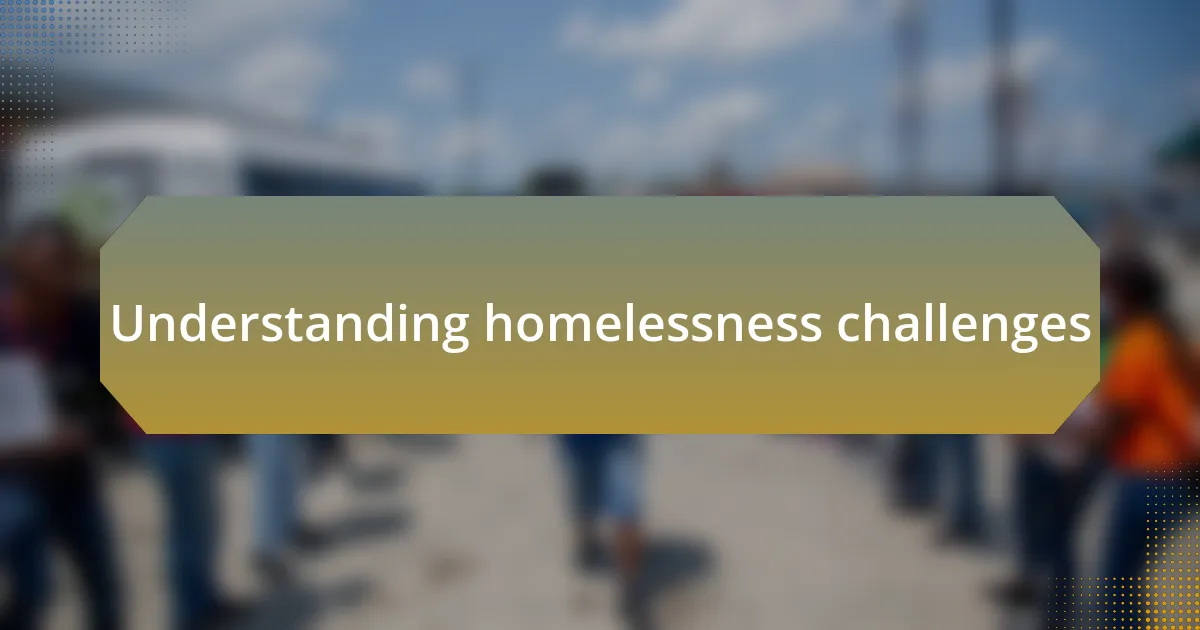
Understanding homelessness challenges
Understanding the challenges of homelessness requires us to look beyond just the lack of shelter. From my interactions with individuals experiencing homelessness, I’ve seen how mental health struggles can compound their situations. Have you ever considered how a single setback, like losing a job or losing housing, can trigger a chain reaction that affects every aspect of a person’s life?
Moreover, I’ve learned that social isolation is a significant challenge. I remember meeting a man who shared that the hardest part wasn’t just the cold nights spent outside, but the feeling of being invisible to society. This deep-seated loneliness can lead to despair, making it even harder for individuals to seek help or rebuild their lives.
Then there’s the stigma associated with homelessness. It’s painful to witness how harsh judgments from others can deter someone from pursuing support services. I often wonder, how many potential stories of resilience go untold because of the fear of rejection? These layers of challenges show that homelessness is not just a physical state, but an emotional and social battle as well.
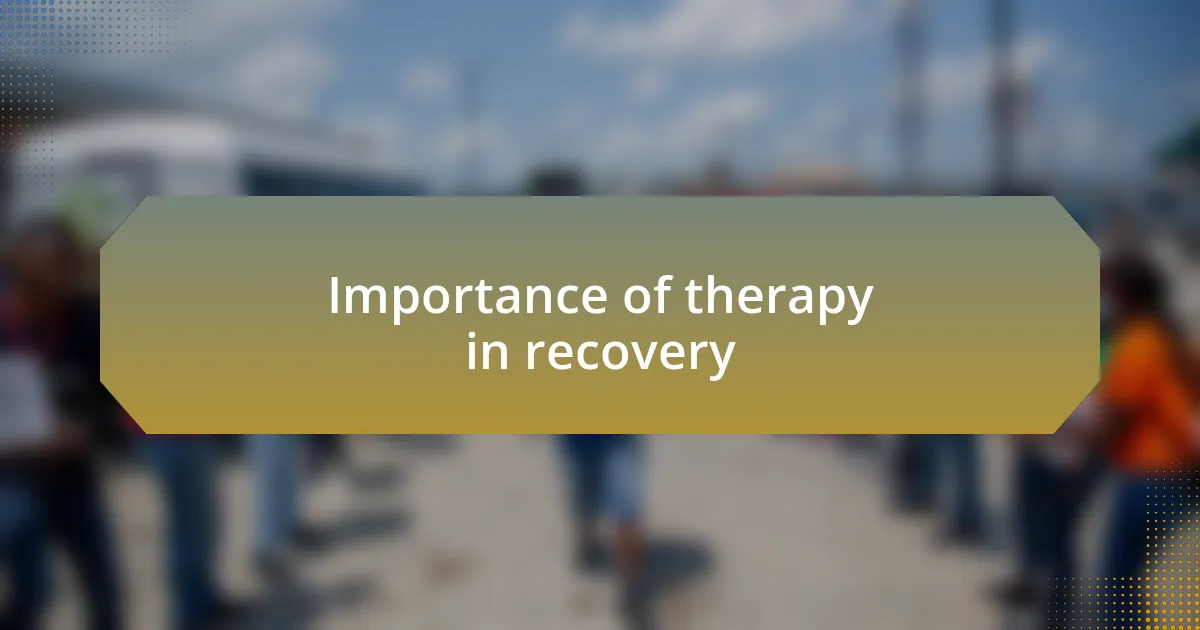
Importance of therapy in recovery
Therapy plays a crucial role in recovery, especially for those rebuilding their lives after experiencing homelessness. I recall a woman I met who utilized therapy to unpack her trauma. It was inspiring to see how each session helped her regain a sense of identity and purpose, demonstrating how mental health support can be a powerful catalyst for change.
In my experience, therapy provides a safe space for individuals to express their feelings and confront painful memories. I once spoke with a man who initially resisted the idea of therapy, fearing it would reopen old wounds. Yet, after several sessions, he shared how sharing his struggles not only eased his burden but also opened doors to opportunities he never thought possible. How often do we underestimate the power of simply being heard?
Moreover, therapy can foster resilience by equipping people with coping strategies and tools to navigate life’s challenges. I’ve seen firsthand how individuals who engage in therapy develop a stronger sense of self-worth and improved relationships. When someone learns to value themselves, they start to envision a future filled with hope. Isn’t it fascinating how therapy can transform not just the individual, but the entire community around them?
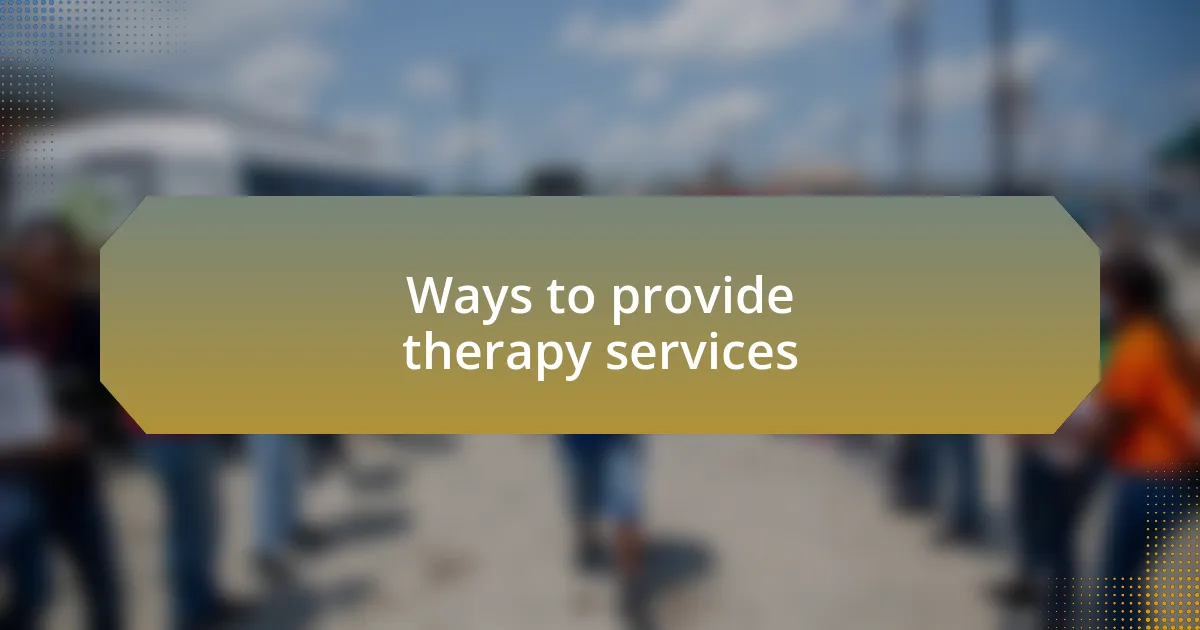
Ways to provide therapy services
Offering therapy services can take many forms, each tailored to meet the unique needs of individuals experiencing homelessness. For instance, I remember a community initiative that organized pop-up therapy clinics in local shelters. This approach brought licensed therapists directly to the individuals in need, removing barriers like transportation and stigma. It was incredible to witness participants gradually opening up in a familiar, supportive environment, leading to remarkable breakthroughs in their recovery journeys.
Another effective way to provide therapy is through group sessions. I attended one where participants shared their experiences and created a sense of camaraderie. Those moments of vulnerability and connection are powerful; they remind us that no one is alone in their struggles. It’s truly moving to see how people can lift each other up, fostering a spirit of solidarity that accelerates healing.
Online therapy services have also emerged as a crucial resource, especially in our increasingly digital world. I recall discussing with a client who benefited from virtual sessions during a lockdown phase. She expressed that having access to therapy from the comfort of her space made her feel safer and more relaxed. Isn’t it interesting how technology can bridge the gap, offering convenience while still facilitating meaningful connections?

Integrating therapy into daily routines
Integrating therapy into daily routines can be surprisingly simple and incredibly effective. I remember a conversation with someone who began using daily affirmations as part of her morning routine. Each morning, she’d take a moment to acknowledge her feelings and set positive intentions for the day. It’s fascinating how such a small act could shift her mindset and create a sense of purpose that carried her through challenging moments.
Another approach I’ve seen work wonders is incorporating therapeutic practices into activities already part of daily life. For example, one individual practiced mindfulness while cooking, focusing on the colors, textures, and smells of the ingredients. This intentional presence helped him reconnect with his emotions and provided a calming ritual amidst the chaos of everyday struggles. Have you ever considered how something as routine as meal preparation could be transformed into a therapeutic experience?
Lastly, I’ve found that integrating therapy into social interactions can be powerful. During one insightful group activity, participants shared not only their stories but also techniques they used to cope with stress. The camaraderie and shared wisdom often inspired individuals to try new tools, like journaling or art therapy, in their own lives. Isn’t it beautiful when a simple conversation can ignite transformative change?
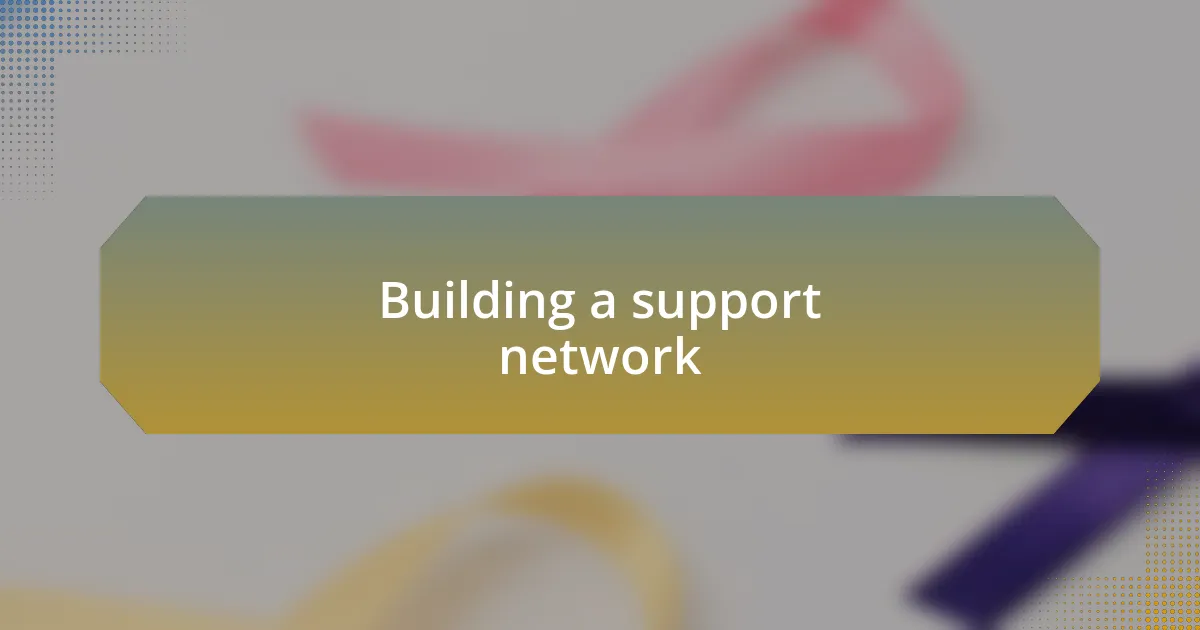
Building a support network
Building a support network is crucial for anyone seeking to integrate therapy into their lives. I recall a time when I joined a local support group, thinking it might just be another social gathering. However, the connections I made there went beyond mere friendship; we became each other’s lifelines, sharing resources, encouraging honesty, and creating a safe space where vulnerability was welcomed. Have you ever felt that sense of relief when you realize you’re not alone in your struggles?
The power of connection cannot be overstated. I once met an individual who was hesitant to open up but found comfort in forming small, meaningful bonds with others facing similar challenges. Over time, these connections evolved into an informal therapy group where we would share our experiences and learn from one another. It was remarkable how these shared moments nurtured a collective healing process that no one had anticipated. Isn’t it fascinating how friendship can blossom from shared pain?
Engaging with those who understand your experiences can truly enrich your healing journey. I remember facilitating a discussion where participants shared strategies for coping with anxiety and depression. It was inspiring to witness how individuals began to lean on each other, exchanging tips on managing triggers and celebrating milestones, no matter how small. This collaborative approach reminded me that when we come together, we can create a stronger foundation for healing and resilience. What support systems do you have in place, and how could they be strengthened?
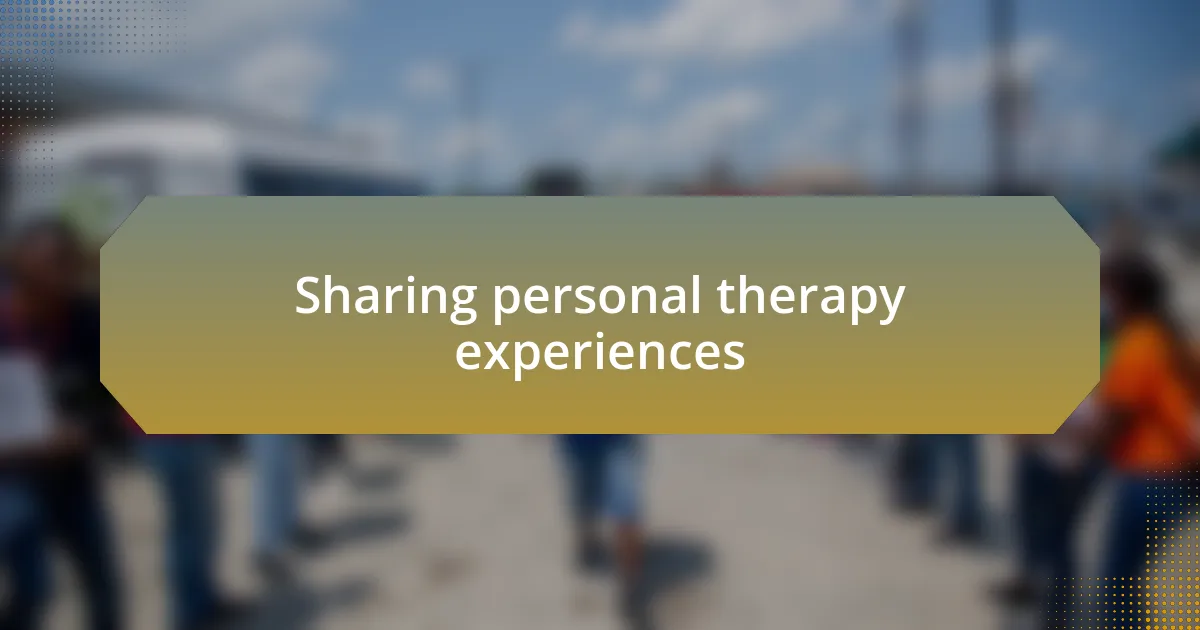
Sharing personal therapy experiences
Sharing personal therapy experiences has always been a transformative aspect of my journey. I vividly recall a session where I hesitated to unveil my deepest fears, but as I listened to others spill their secrets, something shifted within me. Their narratives resonated so deeply that I felt compelled to share my own story. Have you ever been surprised by how much relief follows the act of vulnerability?
I think back to an informal gathering of friends who attended therapy sessions together. One evening, as we swapped stories, laughter and tears intertwined. I shared a moment when therapy helped me untangle feelings of worthlessness. That openness sparked a candid discussion about our collective struggles, making each of us realize we carried similar burdens. Isn’t it powerful how one shared narrative can ignite a chain reaction of healing?
In another instance, I had the opportunity to lead a workshop focused on processing grief. Participants opened their hearts about their losses, creating an atmosphere thick with empathy and understanding. When one individual courageously opened up about her experience of loss, the room fell silent, yet her story inspired others to share their own pain. It struck me how personal testimonies not only foster connection but also empower others to confront their own stories. How often do we underestimate the healing power of shared experiences?
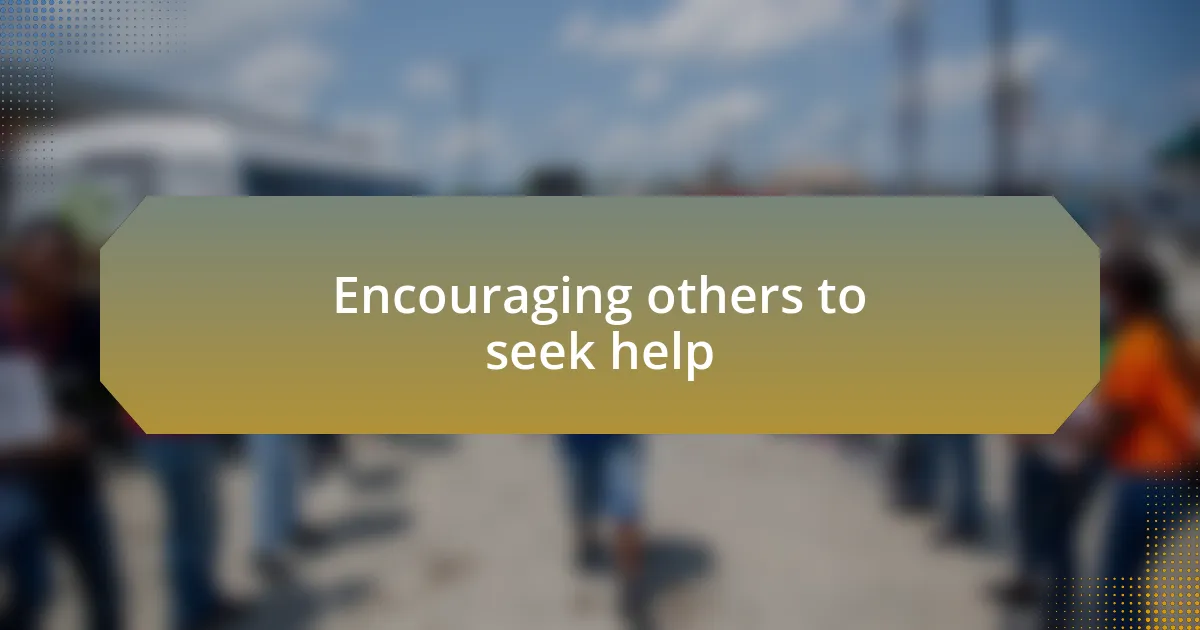
Encouraging others to seek help
Encouraging others to seek help often requires a gentle nudge, one that comes from a place of understanding. I remember a friend who constantly battled her inner demons but resisted the idea of reaching out for support. One day, after sharing a particularly heavy moment from my own therapy journey, she finally broke her silence and admitted she was struggling too. Have you ever seen how a simple revelation can shift someone’s perspective and inspire them to take that first brave step toward healing?
In my experience, creating an inviting space for conversation can make a world of difference. I once hosted a small gathering where the topic of mental health was openly discussed, aiming to normalize the idea of seeking therapy. The atmosphere was filled with vulnerability but also hope, as each person shared their doubts and triumphs. By the end of the evening, attendees were exchanging resources and support, eager to help one another take action. Isn’t it fascinating how community can empower individuals to seek help and take control of their well-being?
Sometimes, the encouragement comes in the form of a simple, heartfelt message. I recall sending a text to a colleague who seemed distant and withdrawn. I offered my support, letting her know that I cared and that therapy had been a game-changer for me. That one message led to an hour-long conversation, breaking down her defenses. It reinforced for me that sometimes, just knowing someone is there can be the catalyst for change. Have you considered how your words might inspire someone else to reach out?